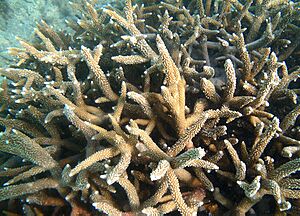Acropora muricata facts for kids
Quick facts for kids Acropora muricata |
|
|---|---|
 |
|
| Conservation status | |
| Scientific classification |
Acropora muricata, often called staghorn coral, is a type of coral. It gets its name because its branches look like a deer's antlers. This coral lives in warm, shallow waters around the world.
You can find staghorn coral in many places. These include the Red Sea, the Indian Ocean, and the Pacific Ocean. It also lives near Australia, Japan, and Southeast Asia. This coral was first described by a scientist named Linnaeus in 1758.
What Does Staghorn Coral Look Like?
Staghorn coral grows in large groups called colonies. These colonies can be very big, up to 10 meters (about 33 feet) wide! They form thick, tree-like patches on the ocean floor.
The branches of this coral can look different depending on how deep the water is. In shallow water, the branches are shorter and more crowded. In deeper water, they are less clumped together.
The coral has special small cups called "corallites" where the tiny coral animals live. Some corallites stick out from the branches. Others are shaped like tubes. Staghorn coral can be blue, brown, or cream colored. The tips of its branches are usually a lighter color.
Where Does Staghorn Coral Live?
Staghorn coral lives in tropical waters. It prefers shallow reefs, the sides of reefs, and calm lagoons. You can find it anywhere from 5 to 30 meters (about 16 to 98 feet) deep.
Its home range includes:
- The Red Sea
- The Persian Gulf
- The Indian Ocean
- Around Australia
- The central Indo-Pacific region
- Japan
- Southeast Asia
- The East China Sea
- The central and western Pacific Ocean
Is Staghorn Coral in Danger?
Yes, staghorn coral is considered a "near threatened" species. This means its population is decreasing. It is listed on the IUCN Red List, which tracks endangered species. It is also protected under CITES Appendix II. This international agreement helps control trade of threatened plants and animals.
Many things threaten staghorn coral:
- Coral bleaching: When ocean temperatures get too warm, corals can get stressed. They lose the tiny algae that live inside them and give them color and food. This makes the coral turn white and can kill it.
- Climate change: Changes in the climate affect ocean temperatures and acidity. This makes it harder for corals to grow and survive.
- Human activities: Pollution, overfishing, and damage from boats or divers can harm coral reefs.
- Diseases: Corals can get sick, just like people.
- Crown-of-thorns starfish: These starfish eat coral. A large number of them can destroy big areas of reef.
Scientists are working to protect staghorn coral and its important reef habitats.


